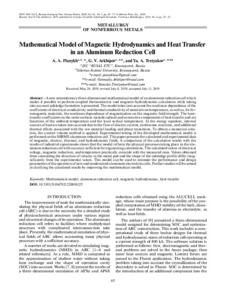Показать сокращенную информацию
Mathematical Model of Magnetic Hydrodynamics and Heat Transfer in an Aluminum Reduction Cell
| Автор | Пьяных, Артем Анатольевич | |
| Автор | Архипов, Геннадий Викторович | |
| Автор | Третьяков, Ярослав Александрович | |
| Дата внесения | 2021-08-13T09:30:22Z | |
| Дата, когда ресурс стал доступен | 2021-08-13T09:30:22Z | |
| Дата публикации | 2020-01 | |
| Библиографическое описание | Пьяных, Артем Анатольевич. Mathematical Model of Magnetic Hydrodynamics and Heat Transfer in an Aluminum Reduction Cell [Текст] / Артем Анатольевич Пьяных, Геннадий Викторович Архипов, Ярослав Александрович Третьяков // Russian Journal of Non-Ferrous Metals. — 2020. — Т. 61 (№ 1). — С. 65-73 | |
| ISSN | 10678212 | |
| URI (для ссылок/цитирований) | https://link.springer.com/article/10.3103/S1067821220010125 | |
| URI (для ссылок/цитирований) | https://elib.sfu-kras.ru/handle/2311/142438 | |
| Описание | Текст статьи не публикуется в открытом доступе в соответствии с политикой журнала. | |
| Аннотация | A new nonstationary three-dimensional mathematical model of an aluminum reduction cell which makes it possible to perform coupled thermoelectric and magneto-hydrodynamic calculation while taking into account sideledge formation is presented. The model takes into account the nonlinear dependence of the coefficients of electrical conductivity and thermal conductivity of materials on temperature, as well as, for ferromagnetic materials, the nonlinear dependence of magnetization on the magnetic field strength. The heat-transfer coefficients on the outer surfaces include radiant and convective components of heat transfer and are functions of the ambient temperature and the local surface temperature. In the energy equation, internal sources of heat are taken into account due to the flow of electric current, exothermic reactions, and additional thermal effects associated with the raw material loading and phase transitions. To obtain a numerical solution, the control volume method is applied. Experimental testing of the developed mathematical model is performed on the S8BME aluminum reduction cell. This paper presents the calculated and experimental data of magnetic, electric, thermal, and hydrodynamic fields. A comparison of the calculation results with the results of industrial experiments shows that the model reflects the physical processes taking place in the aluminum reduction cell with accuracy sufficient for engineering calculations. The calculated values of electrical voltage, magnetic induction, and temperature practically coincide with the measured ones. Values obtained from calculating the direction of velocity in the metal pad and the shape of the sideledge profile differ insignificantly from the experimental values. This model can be used to estimate the performance and design parameters of the operation of new and modernized aluminum electrolysis cells. Further studies will be aimed at clarifying the calculated results by improving the mathematical model. | |
| Тема | Mathematical model | |
| Тема | aluminum reduction cell | |
| Тема | magnetic hydrodynamic | |
| Тема | heat transfer | |
| Название | Mathematical Model of Magnetic Hydrodynamics and Heat Transfer in an Aluminum Reduction Cell | |
| Тип | Journal Article | |
| Тип | Journal Article Preprint | |
| Страницы | 65-73 | |
| Дата обновления | 2021-08-13T09:30:22Z | |
| DOI | 10.3103/S1067821220010125 | |
| Институт | Политехнический институт | |
| Подразделение | Кафедра теплотехники и гидрогазодинамики | |
| Журнал | Russian Journal of Non-Ferrous Metals | |
| Квартиль журнала в Scopus | Q3 | |
| Квартиль журнала в Web of Science | Q4 |

